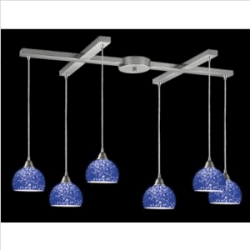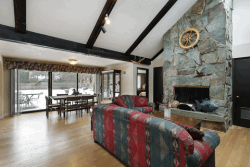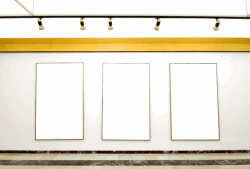Track Lighting Systems: Flexible Accent and Pendant Fixtures
Track lighting systems provide excellent accent and pendant lighting, but are poor for tasks.
Track lighting systems originated in art galleries and museums, and they display their origin in their design. Because museums and art galleries tend to move their display pieces from place to place, they required lights that could provide flexible, focused light to all of their displays, regardless of where they put them. However, these systems quickly moved to home lighting design. Like museums, people appreciated the flexibility that track lighting offered them in decorating their homes. If they wished to move artwork or decorative objects, track lighting could easily serve that purpose. Moreover, some people came to like the “industrial” style that track lighting brings. Having visible tracks gave a room a sense of function mixed with form that itself became desirable. There are various options in designer track lighting that can fill this purpose
In this article, I will discuss the basics of track lighting systems, including the recent development of pendant lighting that is used in conjunction with tracks. By the end, you should be better prepared to make decisions about which track lighting systems are right for you.
Accent Lighting
The primary use for track lighting systems is in accent lighting. Accent lighting refers to using lighting to highlight decorative and architectural features within your home. This can include not only paintings and sculptures, but also such features as attractive stonework or even a group of beautiful pots adorning your kitchen. Regardless of what it is you wish to highlight, track lighting still provides some of the most attractive, flexible lighting you can find.
Most accent lighting is still halogen lighting, though LED lighting fixtures are increasingly taking over. Halogen lighting lasts longer than standard incandescent lighting. Moreover, most halogen bulbs are what are called “reflector bulbs”, indicating that they reflect the light forward in a single direction. However, halogen lighting has some flaws. It is a reddish light, distorting colors, it is not very energy efficient and it emits UV radiation, damaging artwork in the long run (as in, over decades). LED lighting has the strengths of halogen lighting, with its only weakness being its cost, as it costs at least triple what a comparable halogen bulb would cost.
When making decisions about how to use accent lighting, it is important to consider the quality of light that accents produce. Track lighting is both a) directed and b) downlit. That it is directed means that it produces strong shadows that may not be appropriate for what you are accenting. That it is downlit means that it produces those shadows from above, casting the shadows downward. For statues and other decorations, this may be a problem. Try shining a light on your artwork from above (even a flashlight) to get a sense of how your statue will look under track lighting.
Pendant Lighting
A more recent development in track lighting is its use in pendant lighting systems. With pendant track lighting, instead of spotlights, small pendant lights are hung down from the track. In this case, the flexibility is far less important. After all, you won’t be highlighting anything with pendants.

Many track lighting systems, like this one available at Amazon, don’t even look like traditional track lighting.
The reason that pendant track lighting systems have become so popular is that it is an easy way to place multiple pendant lights on a single ceiling without having multiple electrical sources. Using a pendant track system, you can easily place five or more light fixtures across a table or other area. Because they are all a part of the same system, these lights are attractively matched and provide multiple light sources, not a single glaring one.
Pendant track lighting systems are especially powerful in combination with uneven ceilings. Uneven ceilings are notoriously difficult to hang lights from properly, especially pendants. However, using track lighting, you can hang the track evenly using wires and then hang the light fixtures in a level way wherever you wish. The installation can be a little tricky, but once it has been taken care of, it is a great way to handle tough ceilings.
Purchasing Options
Track lighting systems bring with them a number of different options when purchasing. The most common option is to purchase a low-voltage track lighting system (in fact, most spotlight systems are low voltage). A low-voltage system runs a less powerful current, usually 24V or 12V light bulbs as opposed to the standard 120V. This means that less power goes to each individual fixture. While this sounds like it may make for dim lighting, accent lighting doesn’t really need to be very powerful, and pendants shouldn’t be too powerful, since you’ll be using five or more at once.
Another important decision is whether to purchase track lighting in a kit or in pieces. Kits come with a track, a transformer (if it is low voltage) and enough fixtures to fill the entire track. They are the most commonly chosen option, if only for convenience. However, you can also purchase pieces of track lighting systems individually. In general, you will want to match the fixtures, but this gives you more flexibility in the type of fixtures (especially pendants) that you want to purchase.
Track Options
Not all tracks are the traditional straight museum tracks (in fact, many museum tracks aren’t traditional museum tracks either). There are an increasing number of curved and flex track lighting systems available as well. These tracks serve as decoration, look less industrial, and also enhance the flexibility of the track lighting itself. For example, if you wish to use track lighting to illuminate a curved mantle, you can purchase curved tracks that will do so.
Curved track lighting that comes in pieces are often called “monorail tracks”. These are by far the most flexible tracks available. These pieces can be put them together in just about any configuration, limited only by the number of fixtures that your track can handle. Sets come in configurations such as circular or over tracks, which are very good for lighting tables or for hanging from high ceilings.
Tracks don’t all look industrial anymore, either. Some people like the convenience of track lighting, but not the appearance of the tracks. So, tracks sometimes called “classic” or “contemporary” tracks will only vaguely look like the tracks you are used to. They can have appearances from chrome to wrought iron and can be quite decorative in themselves.
Task Lighting?
Kitchen Task Lighting
Using track lighting for kitchen casts harsh shadows and is a common mistake.
One of the biggest mistakes in track lighting is to use it for task lighting. With very few exceptions, track lighting is very poor for task lighting and is heavily overused for it, especially in kitchens. The problem goes back to the quality of light that a track light produces. The fixtures cast strong shadows and cast them downward. As a result, no matter what task you are performing, you will be casting a shadow with your hand over whatever you are doing.
This can be especially dangerous in kitchens, where not only are track lighting systems used for task lighting, they are often placed behind people who are using the countertops. The basic reasoning is that a single track can light multiple counters. However, the result is that people are not only dodging their hands’ shadows, they are dodging their bodies’ shadows as well. This can be downright dangerous when preparing food. Instead, use under-kitchen-cabinet lighting for kitchen tasks.
Putting It All Together
Track lighting has moved from museums to the homes, but not without a few hiccups:
- It provides excellent accent lighting for works of art or decorations.
- It can provide arrays of attractive pendant lighting, especially with difficult ceilings.
- It now comes in a number of different types, including styles that don’t even look like traditional track lights.
- It makes poor task lighting, especially in kitchens, where it can be dangerous.
With all of this in mind, it should be easier to find the task lighting systems that are right for you.
More Track Lighting Articles:
Designer Track Lighting: Track, Fixture and Designer Options
Designer track lighting provides options both for style and lighting quality.
Curved Track Lighting: Flexible, Monorail and Fixed Tracks
Curved track lighting provides texture to your ceiling and flexibility to your lighting design.
Flex Track Lighting: Flexible Kits and Systems for Your Exact Needs
Flex track lighting provides flexible options for lighting hard-to-illuminate areas with a contemporary style.
Modern Track Lighting: Contemporary Styles and Fixtures
Modern track lighting blends new options in tracks and fixtures.


